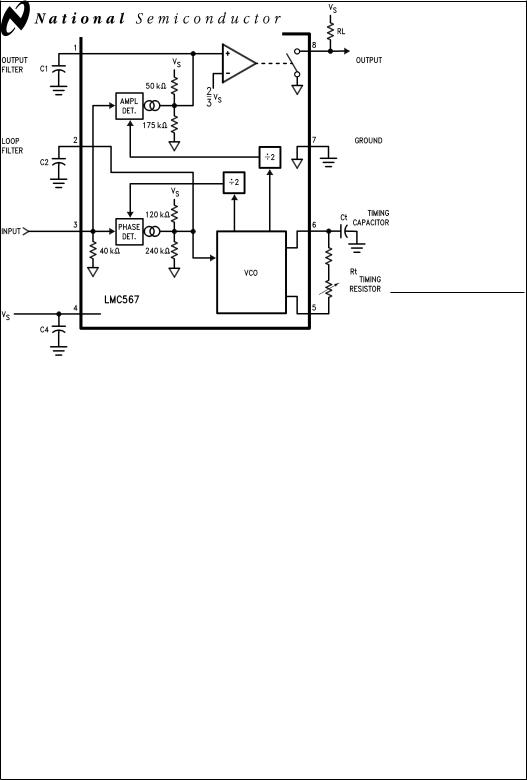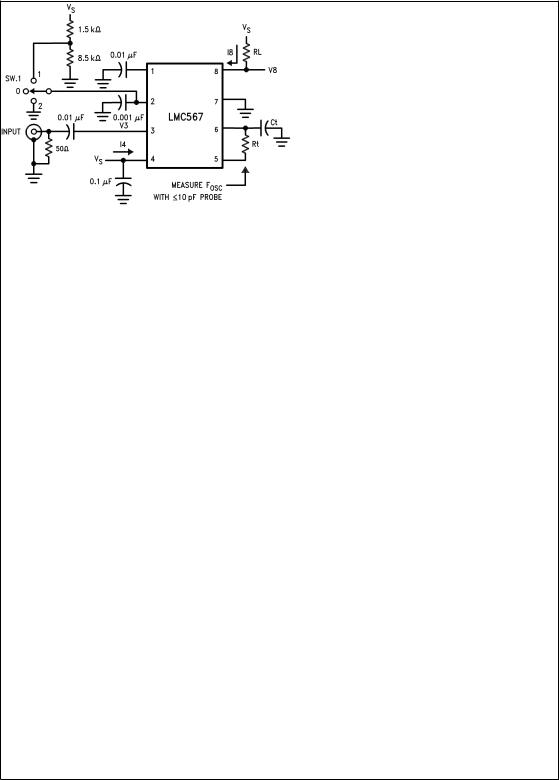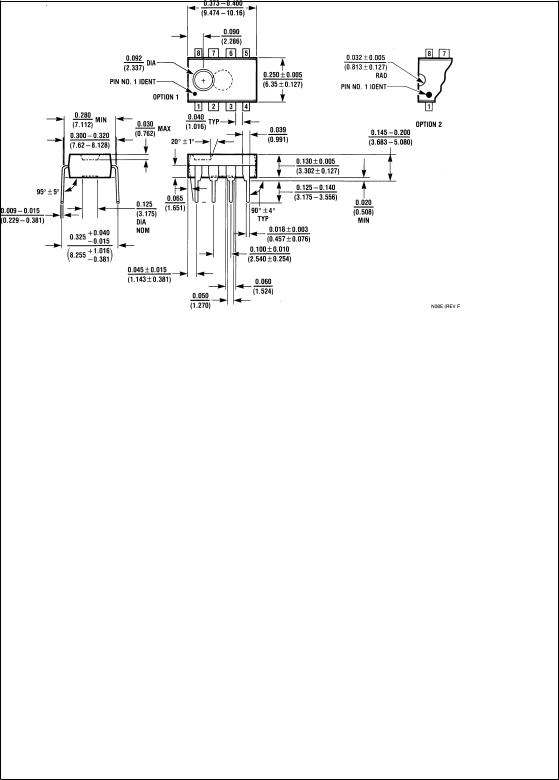
(NSC).LMC567
.pdf
June 1999
LMC567
Low Power Tone Decoder
General Description
The LMC567 is a low power general purpose LMCMOS™ tone decoder which is functionally similar to the industry standard LM567. It consists of a twice frequency voltage-controlled oscillator (VCO) and quadrature dividers which establish the reference signals for phase and amplitude detectors. The phase detector and VCO form a phase-locked loop (PLL) which locks to an input signal frequency which is within the control range of the VCO. When the PLL is locked and the input signal amplitude exceeds an internally pre-set threshold, a switch to ground is activated on the output pin. External components set up the oscillator to run at twice the input frequency and determine the phase and amplitude filter time constants.
Features
nFunctionally similar to LM567
n2V to 9V supply voltage range
nLow supply current drain
nNo increase in current with output activated
nOperates to 500 kHz input frequency
nHigh oscillator stability
nGround-referenced input
nHysteresis added to amplitude comparator
nOut-of-band signals and noise rejected
n20 mA output current capability
Block Diagram (with External Components)
DS008670-1
Order Number LMC567CM or LMC567CN
See NS Package Number M08A or N08E
LMCMOS™ is a trademark of National Semiconductor Corp.
Decoder Tone Power Low LMC567
© 1999 National Semiconductor Corporation |
DS008670 |
www.national.com |

Absolute Maximum Ratings (Note 1)
If Military/Aerospace specified devices are required, please contact the National Semiconductor Sales Office/ Distributors for availability and specifications.
Input Voltage, Pin 3 |
2 Vp±p |
Supply Voltage, Pin 4 |
10V |
Output Voltage, Pin 8 |
13V |
Voltage at All Other Pins |
Vs to Gnd |
Output Current, Pin 8 |
30 mA |
Package Dissipation |
500 mW |
Operating Temperature Range (TA) |
−25ÊC to +125ÊC |
Storage Temperature Range |
−55ÊC to +150ÊC |
Soldering Information |
|
Dual-In-Line Package |
|
Soldering (10 sec.) |
260ÊC |
Small Outline Package |
|
Vapor Phase (60 sec.) |
215ÊC |
Infrared (15 sec.) |
220ÊC |
See AN-450 ªSurface Mounting Methods and Their Effect on Product Reliabilityº for other methods of soldering surface mount devices.
Electrical Characteristics
Test Circuit, TA = 25ÊC, Vs = 5V, RtCt #2, Sw. 1 Pos. 0, and no input, unless otherwise noted.
Symbol |
Parameter |
Conditions |
|
Min |
Typ |
Max |
Units |
|
|
|
|
|
|
|
|
I4 |
Power Supply |
RtCt #1, Quiescent |
Vs = 2V |
|
0.3 |
|
|
|
Current |
or Activated |
Vs = 5V |
|
0.5 |
0.8 |
mAdc |
|
|
|
Vs = 9V |
|
0.8 |
1.3 |
|
V3 |
Input D.C. Bias |
|
|
|
0 |
|
mVdc |
|
|
|
|
|
|
|
|
R3 |
Input Resistance |
|
|
|
40 |
|
kΩ |
|
|
|
|
|
|
|
|
I8 |
Output Leakage |
|
|
|
1 |
100 |
nAdc |
|
|
|
|
|
|
|
|
f0 |
Center Frequency, |
RtCt #2, Measure Oscillator |
Vs = 2V |
|
98 |
|
|
|
Fosc ÷ 2 |
Frequency and Divide by 2 |
Vs = 5V |
92 |
103 |
113 |
kHz |
|
|
|
Vs = 9V |
|
105 |
|
|
f0 |
Center Frequency |
|
|
|
|
|
|
|
Shift with Supply |
|
|
|
1.0 |
2.0 |
%/V |
|
|
|
|
|
|
|
|
Vin |
Input Threshold |
Set Input Frequency Equal to f0 |
Vs = 2V |
11 |
20 |
27 |
|
|
|
Measured Above, Increase Input Level |
Vs = 5V |
17 |
30 |
45 |
mVrms |
|
|
Until Pin 8 Goes Low. |
|
|
|
|
|
|
|
Vs = 9V |
|
45 |
|
|
|
|
|
|
|
|
|
||
Vin |
Input Hysteresis |
Starting at Input Threshold, Decrease Input |
|
|
1.5 |
|
mVrms |
|
|
Level Until Pin 8 goes High. |
|
|
|
||
|
|
|
|
|
|
|
|
|
|
|
|
|
|
|
|
V8 |
Output 'Sat' Voltage |
Input Level > Threshold |
I8 = 2 mA |
|
0.06 |
0.15 |
Vdc |
|
|
Choose RL for Specified I8 |
I8 = 20 mA |
|
0.7 |
|
|
|
|
|
|
|
|||
|
|
|
|
|
|
|
|
L.D.B.W. |
Largest Detection |
Measure Fosc with Sw. 1 in |
Vs = 2V |
7 |
11 |
15 |
|
|
Bandwidth |
Pos. 0, 1, and 2; |
|
|
|
|
|
|
Vs = 5V |
11 |
14 |
17 |
% |
||
|
|
|
|||||
|
|
|
|
|
|
|
|
|
|
|
Vs = 9V |
|
15 |
|
|
|
|
|
|
|
|
|
|
BW |
Bandwidth Skew |
|
|
|
|
|
|
|
|
|
|
|
0 |
±1.0 |
% |
|
|
|
|
|
|
|
|
fmax |
Highest Center |
RtCt #3, Measure Oscillator Frequency and Divide by 2 |
|
700 |
|
kHz |
|
|
Freq. |
|
|
|
|
||
|
|
|
|
|
|
|
|
|
|
|
|
|
|
|
|
Vin |
Input Threshold at |
Set Input Frequency Equal to fmax measured Above, |
|
35 |
|
mVrms |
|
|
fmax |
Increase Input Level Until Pin 8 goes Low. |
|
|
|
|
|
|
|
|
|
|
|
||
Note 1: Absolute Maximum Ratings indicate limits beyond which damage to the device may occur. Operating Ratings indicate conditions for which the device is functional, but do not guarantee specific performance limits. Electrical Characteristics state DC and AC electrical specifications under particular test conditions which guarantee specific performance limits. This assumes that the device is within the Operating Ratings. Specifications are not guaranteed for parameters where no limit is given, however, the typical value is a good indication of device performance.
www.national.com |
2 |

Test Circuit
DS008670-2
RtCt |
Rt |
Ct |
|
|
|
#1 |
100k |
300 pF |
#2 |
10k |
300 pF |
#3 |
5.1k |
62 pF |
|
|
|
3 |
www.national.com |

Typical Performance Characteristics
Supply Current vs. |
Bandwidth vs. |
Largest Detection |
Operating Frequency |
Input Signal Level |
Bandwidth vs. Temp. |
|
DS008670-3 |
DS008670-7 |
DS008670-8 |
|
|
||
Bandwidth as |
|
Frequency Drift |
Frequency Drift |
a Function of C2 |
|
with Temperature |
with Temperature |
DS008670-9
Applications Information (refer to Block
Diagram)
GENERAL
The LMC567 low power tone decoder can be operated at supply voltages of 2V to 9V and at input frequencies ranging from 1 Hz up to 500 kHz.
The LMC567 can be directly substituted in most LM567 applications with the following provisions:
1.Oscillator timing capacitor Ct must be halved to double the oscillator frequency relative to the input frequency (See OSCILLATOR TIMING COMPONENTS).
2.Filter capacitors C1 and C2 must be reduced by a factor of 8 to maintain the same filter time constants.
3.The output current demanded of pin 8 must be limited to the specified capability of the LMC567.
OSCILLATOR TIMING COMPONENTS
The voltage-controlled oscillator (VCO) on the LMC567 must be set up to run at twice the frequency of the input signal tone to be decoded. The center frequency of the VCO is set by timing resistor Rt and timing capacitor Ct connected to pins 5 and 6 of the IC. The center frequency as a function of Rt and Ct is given by:
Since this will cause an input tone of half Fosc to be decoded,
DS008670-10 |
DS008670-11 |
This equation is accurate at low frequencies; however, above 50 kHz (Fosc = 100 kHz), internal delays cause the actual frequency to be lower than predicted.
The choice of Rt and Ct will be a tradeoff between supply current and practical capacitor values. An additional supply current component is introduced due to Rt being switched to Vs every half cycle to charge Ct:
Is due to Rt = Vs/(4Rt)
Thus the supply current can be minimized by keeping Rt as large as possible (see supply current vs. operating frequency curves). However, the desired frequency will dictate an RtCt product such that increasing Rt will require a smaller Ct. Below Ct = 100 pF, circuit board stray capacitances begin to play a role in determining the oscillation frequency which ultimately limits the minimum Ct.
To allow for I.C. and component value tolerances, the oscillator timing components will require a trim. This is generally accomplished by using a variable resistor as part of Rt, although Ct could also be padded. The amount of initial frequency variation due to the LMC567 itself is given in the electrical specifications; the total trim range must also accommodate the tolerances of Rt and Ct.
www.national.com |
4 |

Applications Information (refer to Block
Diagram) (Continued)
SUPPLY DECOUPLING
The decoupling of supply pin 4 becomes more critical at high supply voltages with high operating frequencies, requiring C4 to be placed as close as possible to pin 4.
INPUT PIN
The input pin 3 is internally ground-referenced with a nominal 40 kΩ resistor. Signals which are already centered on 0V may be directly coupled to pin 3; however, any d.c. potential must be isolated via a coupling capacitor. Inputs of multiple LMC567 devices can be paralleled without individual d.c. isolation.
LOOP FILTER
Pin 2 is the combined output of the phase detector and control input of the VCO for the phase-locked loop (PLL). Capacitor C2 in conjunction with the nominal 80 kΩ pin 2 internal resistance forms the loop filter.
For small values of C2, the PLL will have a fast acquisition time and the pull-in range will be set by the built in VCO frequency stops, which also determine the largest detection bandwidth (LDBW). Increasing C2 results in improved noise immunity at the expense of acquisition time, and the pull-in range will begin to become narrower than the LDBW (see Bandwidth as a Function of C2 curve). However, the maximum hold-in range will always equal the LDBW.
OUTPUT FILTER
Pin 1 is the output of a negative-going amplitude detector which has a nominal 0 signal output of 7/9 Vs. When the PLL is locked to the input, an increase in signal level causes the detector output to move negative. When pin 1 reaches 2/3 Vs the output is activated (see OUTPUT PIN).
Capacitor C1 in conjunction with the nominal 40 kΩ pin 1 internal resistance forms the output filter. The size of C1 is a tradeoff between slew rate and carrier ripple at the output comparator. Low values of C1 produce the least delay between the input and output for tone burst applications, while larger values of C1 improve noise immunity.
Pin 1 also provides a means for shifting the input threshold higher or lower by connecting an external resistor to supply or ground. However, reducing the threshold using this technique increases sensitivity to pin 1 carrier ripple and also results in more part to part threshold variation.
OUTPUT PIN
The output at pin 8 is an N-channel FET switch to ground which is activated when the PLL is locked and the input tone is of sufficient amplitude to cause pin 1 to fall below 2/3 Vs. Apart from the obvious current component due to the external pin 8 load resistor, no additional supply current is required to activate the switch. The on resistance of the switch is inversely proportional to supply; thus the ªsatº voltage for a given output current will increase at lower supplies.
5 |
www.national.com |

Physical Dimensions inches (millimeters) unless otherwise noted
Molded Small Outline (SO) Package (M)
Order Number LMC567CM
NS Package Number M08A
Molded Dual-In-Line Package (N)
Order Number LMC567CN
NS Package Number N08E
www.national.com |
6 |

Notes
LIFE SUPPORT POLICY
NATIONAL'S PRODUCTS ARE NOT AUTHORIZED FOR USE AS CRITICAL COMPONENTS IN LIFE SUPPORT DEVICES OR SYSTEMS WITHOUT THE EXPRESS WRITTEN APPROVAL OF THE PRESIDENT AND GENERAL COUNSEL OF NATIONAL SEMICONDUCTOR CORPORATION. As used herein:
1. Life support devices or systems are devices or |
2. A critical component is any component of a life |
systems which, (a) are intended for surgical implant |
support device or system whose failure to perform |
into the body, or (b) support or sustain life, and |
can be reasonably expected to cause the failure of |
whose failure to perform when properly used in |
the life support device or system, or to affect its |
accordance with instructions for use provided in the |
safety or effectiveness. |
labeling, can be reasonably expected to result in a |
|
significant injury to the user.
National Semiconductor |
National Semiconductor |
National Semiconductor |
National Semiconductor |
||||
Corporation |
Europe |
|
|
|
|
Asia Pacific Customer |
Japan Ltd. |
Americas |
|
Fax: |
+49 (0) 1 80-530 85 86 |
Response Group |
Tel: 81-3-5639-7560 |
||
Tel: 1-800-272-9959 |
Email: europe.support@nsc.com |
Tel: 65-2544466 |
Fax: 81-3-5639-7507 |
||||
Fax: 1-800-737-7018 |
Deutsch |
Tel: +49 |
(0) |
1 80-530 85 85 |
Fax: 65-2504466 |
|
|
Email: support@nsc.com |
English |
Tel: |
+49 |
(0) |
1 80-532 78 32 |
Email: sea.support@nsc.com |
|
|
Français Tel: |
+49 (0) 1 80-532 93 58 |
|
|
|||
www.national.com |
Italiano |
Tel: |
+49 |
(0) |
1 80-534 16 80 |
|
|
Decoder Tone Power Low LMC567
National does not assume any responsibility for use of any circuitry described, no circuit patent licenses are implied and National reserves the right at any time without notice to change said circuitry and specifications.
